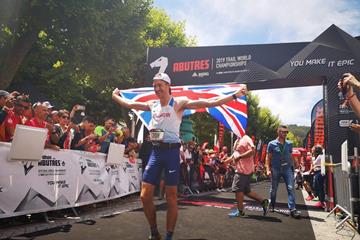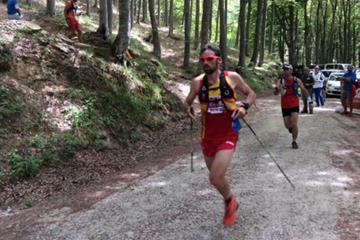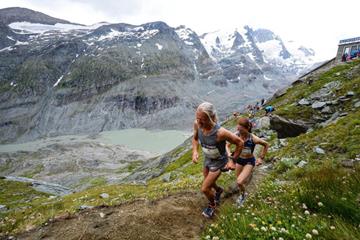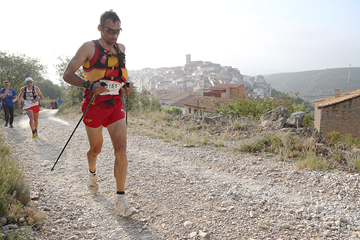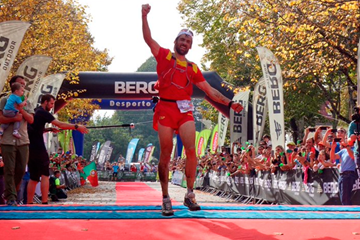 Countdown
Countdown
 Countdown
Countdown
Official website: International Trail Running Association
Official website: World Mountain Running Association
How it works
Mountain and trail running is a form of endurance running where athletes race each other to record the fastest time over a set course. In the shorter events women and men race separately and in the longer ones they run together.
The discipline takes place on various types of natural terrain (sand, dirt, forest paths, single track footpaths, snow trails, etc) and in various kinds of environment (mountains, forests, plains, deserts, etc). While some races call themselves mountain races and some trail races, there is often considerable overlap.
Races take place mostly on off-road surfaces, however sections of paved surfaces (e.g. asphalt, concrete, macadam, etc) are acceptable as a way to reach or link the trails of the course but should be kept to a minimum and not exceed 25% of the total length. Preferably existing roads and trails should be used.
Courses must be laid out and marked in such a way that no navigation skills will be required from the athletes or require the use of specific equipment, such as mountaineering equipment. The use of hiking poles is permitted at the discretion of the race organiser, especially in longer races. Again, especially in longer races, the race organiser may recommend or impose mandatory equipment, such as minimum clothing, windjackets, headlamps, water and food, due to the conditions expected to be encountered during the event.
Courses must be designed to ensure the safety of athletes and officials. Specific conditions, such as high altitude, changing weather conditions and available infrastructure, should be respected. Importantly, they should be designed to both showcase the natural environment of the host venue and fully respect the natural environment within which the events take place.
For the World Championships, races are held over the distances stated in the table below, and all courses must be measured in such a way as to create an accurate GPX track file that provides distance and elevation (gain and loss).
| Race | Distance | Elevation | Ideal men's winning time |
| Long Trail | 75-85km | 3500m-6000m | 7hr 45 to 8hr 15 |
| Short Trail | 35-45km | 2000m-3000m | 3hr 45 to 4hr 15 |
| Senior Classic (up and down) |
12-15km | 600m-900m | 55-60 minutes |
| Junior Classic (up and down) |
5-7km | 300m-450m | 25-30 minutes |
| Senior Uphill | 4-7km | 700m-1000m (average incline should be more than 10%) |
40-50 minutes |
History
Mountain and trail running have a long history. Distance runners have long run on trails to train and have done so in the mountains to prepare for other events. Formally the World Mountain Running Association (WMRA) was born in 1984 as the International Committee of Mountain Running (ICMR). In 1985, it first staged ‘the World Trophy’, attracting entries from more than 30 countries. In 2002, the IAAF (now World Athletics) Congress officially recognised it as an International Competition and in 2009 the name was changed to the Mountain Running World Championships.
It is difficult to pinpoint the first formal trail running races. Perhaps the earliest known is the Dipsea Trail Race dating from 1905. Other well-known events started in the 1970s, including the Western States 100 Mile Endurance Run (1974) and Sierre Zinal (1977).
Trail running experienced a boom in the 2000s, with the first edition of the UTMB® in 2003. The International Trail Running Association (ITRA) was founded in 2013, with the aim to promote trail running around the world and give voice to all parties involved in the sport, and the first World Trail Running Championships was held in 2007.
In 2017, recognising the similarities and overlap between mountain running and trail running, World Athletics, WMRA and ITRA worked together to create one definition, Rule 57 of the World Athletics rule book, and in 2021 the first ever combined world championships was held – the World Mountain and Trail Running Championships (WMTRC) in Thailand.
This event, delayed one year by Covid, was part of the realigned global calendar, with the WMTRC being held in even years, and regional championships in odd years (the European championships is called the European Athletics Off Road Running Championship).
Did you know
As well as the world and regional championships, mountain and trail runners are able to take part in a number of annual global series such as the WMRA World Cup, the World Trail Majors, the Golden Trail Series and the UTMB series.
Runners’ performances are ranked both by ITRA’s Performance Index (which evaluates the performance of each runner and can be used to compare the speed of all runners, at all levels, from all around the world, even of athletes who have never run the in same race) and the WMRA World Ranking (based on race performances).
Killian Jornet (Spain)
One of the best known ultra trail runners and ski mountaineers, renowned for his exploits in the mountains. Jornet is a multiple winner of both the UTMB (four times) and Sierre Zinal (seven times), setting course records in both. A regular winner on the Sky Runner World Series, he has also won the Western States and Hardrock 100s, as well as setting numerous fastest known times for many trail routes and mountain ascents/descents including the Matterhorn and Mont Blanc.
Courtney Dauwalter (USA)
Dauwalter is as one of the world's best ultra trail runners, known for setting new boundaries for human performance. With a focus on longer events, she has won more than 50 races of 50km or longer in the last 10 years. In 2023 she won the Western States, Hardrock and the UTMB, the first person ever to win the three 100 mile races in one year, setting records in the first two. A four-time winner of the UTMB, Dauwalter was ultrarunner of the year in 2018.
Andrea Mayer (Austria)
The most dominant female mountain runner over the last near two decades, especially on uphill courses, Mayer is a seven-time world mountain running champion, including in 2023 at the 2nd World Mountain and Trail Running Championships, Innsbruck, Austria, her home country. As well as her exceptional performances over the mountains from 2006 to date, Mayer represented Austria in the 2012 Olympic marathon and the steeplechase at the 2005 and 2007 World Championships. She has a marathon best of 2:30:34 set when winning the Vienna Marathon in 2009.
Jonathan Wyatt (New Zealand)
In his prime, near unbeatable, Wyatt won the World Mountain Running Championships six times between 1998-2008. While often considered a better uphill than classic (up and down) athlete, Wyatt's wins included the up and down World Championship in front of a home crowd in New Zealand in 2005. Wyatt had numerous other wins in iconic mountain races, including winning Sierre Zinal twice, the Jungfrau marathon three times and the Red Bull Dolomitenmann five times. Wyatt is also a two-time Olympian – in the 5000m in 1996 and marathon in 2004 – and he competed in the 1994 and 2002 Commonwealth Games.
Joyce Njeru (Kenya)
Inspired by her compatriot, fellow Kenyan mountain runner and two-time mountain running world champion and two-time WMRA World Cup winner Lucy Wambui Murigi, Njeru is a three-time winner of the WMRA Valsir World Cup (2021, 2022 and 2023), the annual season-long mountain running circuit, where she has become a dominant force.
Marco De Gasperi (Italy)
Equally at home over mountain and longer trail races, De Gasperi has won the World Mountain Running Championships five times, as well as finishing on the individual podium at the European Mountain Running Championships five times. A member of the dominant Italian mountain running team, winning numerous world team titles at both classic and long distance, he also has had numerous other victories, including winning Sierre Zinal three times.
